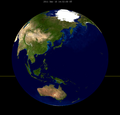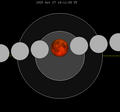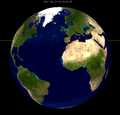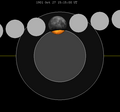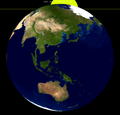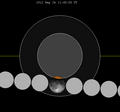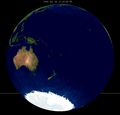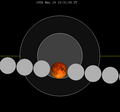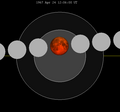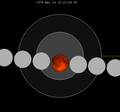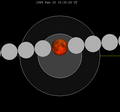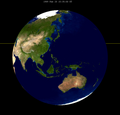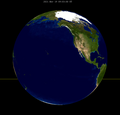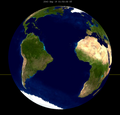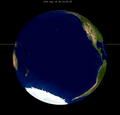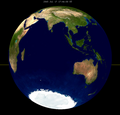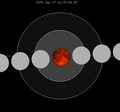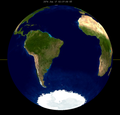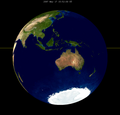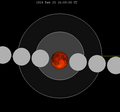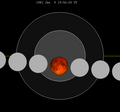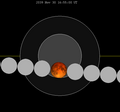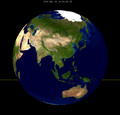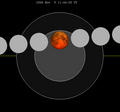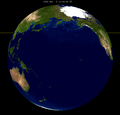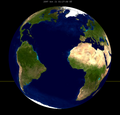Top Qs
Timeline
Chat
Perspective
December 2010 lunar eclipse
Total Lunar eclipse of 21 December 2010 From Wikipedia, the free encyclopedia
Remove ads
A total lunar eclipse occurred at the Moon’s descending node of orbit on Tuesday, 21 December 2010,[1] with an umbral magnitude of 1.2576. A lunar eclipse occurs when the Moon moves into the Earth's shadow, causing the Moon to be darkened. A total lunar eclipse occurs when the Moon's near side entirely passes into the Earth's umbral shadow. Unlike a solar eclipse, which can only be viewed from a relatively small area of the world, a lunar eclipse may be viewed from anywhere on the night side of Earth. A total lunar eclipse can last up to nearly two hours, while a total solar eclipse lasts only a few minutes at any given place, because the Moon's shadow is smaller. Occurring about 4 days before apogee (on 25 December 2010, at 7:15 UTC), the Moon's apparent diameter was smaller.[2]
This eclipse was notable in that it coincided with the date of the Winter solstice in the Northern Hemisphere and Summer solstice in the Southern Hemisphere. It was the first total lunar eclipse to occur on the day of the Northern Winter Solstice (Southern Summer Solstice) since 1638, and only the second in the Common Era.[3][4]
Remove ads
Visibility
The eclipse was completely visible over North America and the eastern Pacific Ocean, seen rising over east Asia and Australia and setting over South America, west Africa, and Europe.[5]
 |
 Hourly motion shown right to left |
 The Moon's hourly motion across the Earth's shadow in the constellation of Taurus. |
 Visibility map | ||
Images
 These simulated views of the Earth from the center of the Moon during the lunar eclipse show where the eclipse is visible on Earth. |

Gallery
 Progression from São Paulo, Brazil | |
 Progression from Anchorage, Alaska | |
 Panorama showing the view from the site of the VLT | |
 Sequence from Toronto, Ontario, Canada (Sequence is in 15-minute increments, with 5-minute increments up until totality at 8:17 am UTC) |
 Progression from Toronto, Canada |
 From Jacksonville, Florida, 8:29 UTC - 10:06 UTC |
 From Easton, Pennsylvania |
Individual shots, sorted by time:
- From New York City, New York, 5:35 UTC
- From Arlington County, Virginia, ~7:30 UTC
- From New York City, New York, 7:38 UTC
- From Seattle, Washington, beginning of totality, 7:41 UTC[6]
- From the Lower Mainland of British Columbia, Canada, 7:46 UTC
- From Miami, Florida, 7:52 UTC
- From Richardson, Texas, 7:53 UTC
- From Dover, Delaware, 7:54 UTC
- Lower Mainland of British Columbia, Canada during totality, 8:21 UTC
- From Toronto, Ontario, Canada, 8:26 UTC
- From Orlando, Florida, 8:28 UTC
- From Jacksonville, Florida, 8:30 UTC
- Amateur scientists observing eclipse in Villa Gesell, Argentina, 8:34 UTC
- From Tucson, Arizona, 8:44 UTC
- From Longjing District, Taichung, Taiwan at moonrise, 9:45 UTC
Animations:
- Animated Simulation
- Time-lapsed animation
Miami, Florida
Timing
Summarize
Perspective
In North America, the eclipse was visible in its entirety on 21 December 2010, from 12:27 a.m. to 6:06 a.m. Eastern Standard Time.[7] In the Central Standard Time zone and west, the eclipse began the night of 20 December.[8] Observers along South America's east coast missed the late stages of the eclipse because they occurred after moon-set.[9]
Likewise much of Europe and Africa experienced moon-set while the eclipse was in progress. In Europe, only those observers in northern Scandinavia (including Iceland), Ireland and Britain could observe the entire event. For observers in eastern Asia the moon rose in eclipse. The eclipse was not visible from southern and eastern Africa, the Middle East or South Asia. In Japan and northeastern Asia, the eclipse's end was visible, with the moon rising at sunset. In the Philippines it was observable as a partial lunar eclipse just after sunset.[9]
Predictions suggested that the total eclipse may appear unusually orange or red, as a result of the eruption of Mount Merapi in Indonesia on 26 October.[10]
Remove ads
Eclipse details
Shown below is a table displaying details about this particular solar eclipse. It describes various parameters pertaining to this eclipse.[11]
Remove ads
Eclipse season
This eclipse is part of an eclipse season, a period, roughly every six months, when eclipses occur. Only two (or occasionally three) eclipse seasons occur each year, and each season lasts about 35 days and repeats just short of six months (173 days) later; thus two full eclipse seasons always occur each year. Either two or three eclipses happen each eclipse season. In the sequence below, each eclipse is separated by a fortnight.
Remove ads
Related eclipses
Summarize
Perspective
Eclipses in 2010
- An annular solar eclipse on January 15.
- A partial lunar eclipse on June 26.
- A total solar eclipse on July 11.
- A total lunar eclipse on 21 December.
Metonic
- Preceded by: Lunar eclipse of March 3, 2007
- Followed by: Lunar eclipse of October 8, 2014
Tzolkinex
- Preceded by: Lunar eclipse of November 9, 2003
- Followed by: Lunar eclipse of January 31, 2018
Half-Saros
- Preceded by: Solar eclipse of December 14, 2001
- Followed by: Solar eclipse of December 26, 2019
Tritos
- Preceded by: Lunar eclipse of January 21, 2000
- Followed by: Lunar eclipse of November 19, 2021
Lunar Saros 125
- Preceded by: Lunar eclipse of December 9, 1992
- Followed by: Lunar eclipse of December 31, 2028
Inex
- Preceded by: Lunar eclipse of January 10, 1982
- Followed by: Lunar eclipse of November 30, 2039
Triad
- Preceded by: Lunar eclipse of February 20, 1924
- Followed by: Lunar eclipse of October 21, 2097
Lunar eclipses of 2009–2013
This eclipse is a member of a semester series. An eclipse in a semester series of lunar eclipses repeats approximately every 177 days and 4 hours (a semester) at alternating nodes of the Moon's orbit.[12]
The penumbral lunar eclipses on February 9, 2009 and August 6, 2009 occur in the previous lunar year eclipse set, and the lunar eclipses on April 25, 2013 (partial) and October 18, 2013 (penumbral) occur in the next lunar year eclipse set.
Metonic series
The Metonic cycle repeats nearly exactly every 19 years and represents a Saros cycle plus one lunar year. Because it occurs on the same calendar date, the Earth's shadow will be in nearly the same location relative to the background stars.
Saros 125
This eclipse is a part of Saros series 125, repeating every 18 years, 11 days, and containing 72 events. The series started with a penumbral lunar eclipse on July 17, 1163. It contains partial eclipses from January 17, 1470 through June 6, 1686; total eclipses from June 17, 1704 through March 19, 2155; and a second set of partial eclipses from March 29, 2173 through June 25, 2317. The series ends at member 72 as a penumbral eclipse on September 9, 2443.
The longest duration of totality was produced by member 37 at 100 minutes, 23 seconds on August 22, 1812. All eclipses in this series occur at the Moon’s descending node of orbit.[13]
Eclipses are tabulated in three columns; every third eclipse in the same column is one exeligmos apart, so they all cast shadows over approximately the same parts of the Earth.
Tritos series
This eclipse is a part of a tritos cycle, repeating at alternating nodes every 135 synodic months (≈ 3986.63 days, or 11 years minus 1 month). Their appearance and longitude are irregular due to a lack of synchronization with the anomalistic month (period of perigee), but groupings of 3 tritos cycles (≈ 33 years minus 3 months) come close (≈ 434.044 anomalistic months), so eclipses are similar in these groupings.
Inex series
This eclipse is a part of the long period inex cycle, repeating at alternating nodes, every 358 synodic months (≈ 10,571.95 days, or 29 years minus 20 days). Their appearance and longitude are irregular due to a lack of synchronization with the anomalistic month (period of perigee). However, groupings of 3 inex cycles (≈ 87 years minus 2 months) comes close (≈ 1,151.02 anomalistic months), so eclipses are similar in these groupings.
Half-Saros cycle
A lunar eclipse will be preceded and followed by solar eclipses by 9 years and 5.5 days (a half saros).[15] This lunar eclipse is related to two annular solar eclipses of Solar Saros 132.
| December 14, 2001 | December 26, 2019 |
|---|---|
 |
 |
Remove ads
See also
Notes
External links
Wikiwand - on
Seamless Wikipedia browsing. On steroids.
Remove ads



































